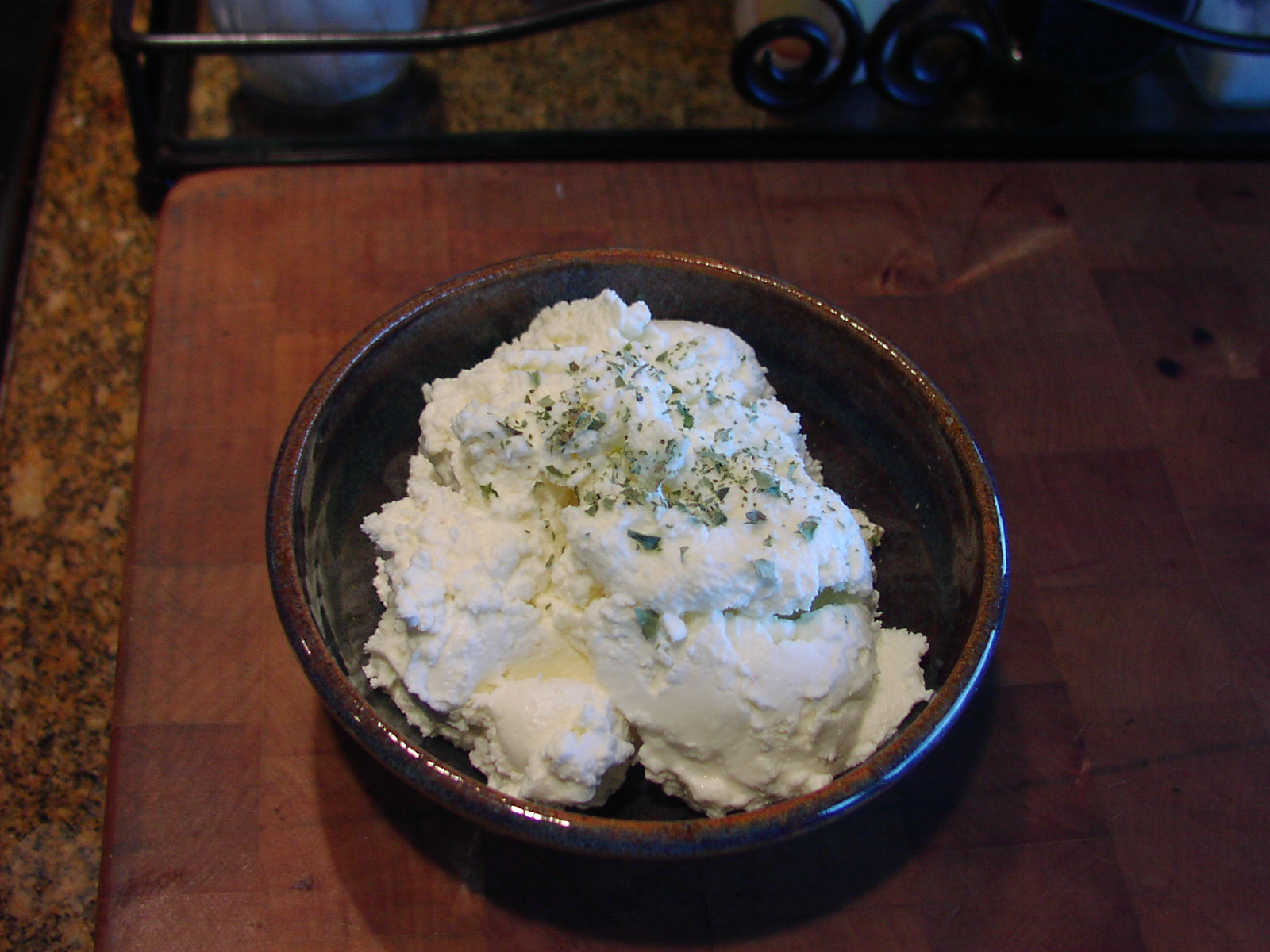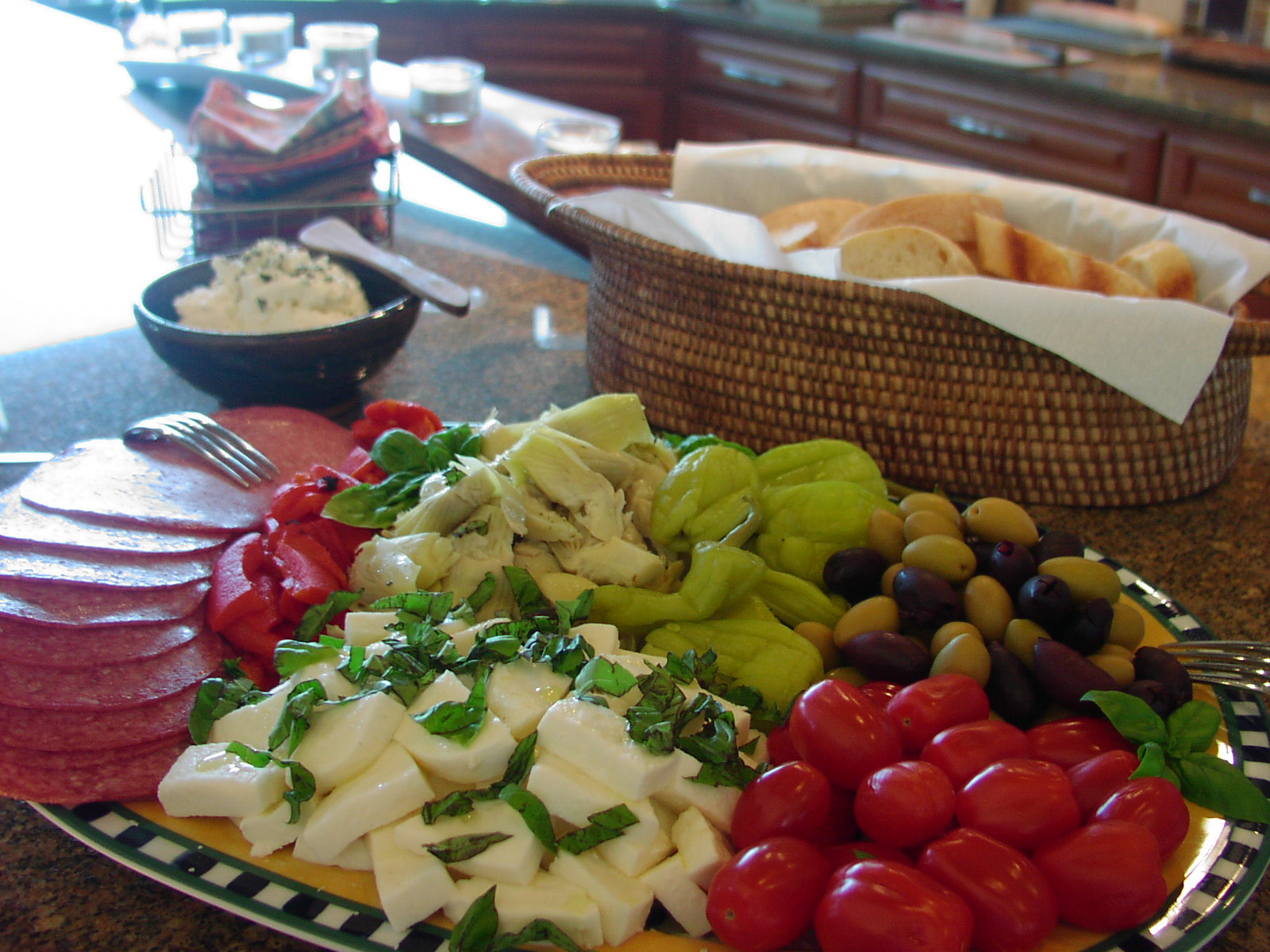OK, as you well know, I am not a lover of buying products from the grocery store that I know I can make better, usually cheaper, and not coincidentally, free of most of the unhealthy additives found in most pre-packages foods. (Now granted, I can’t make some types of bread as well as artisan bakers, but mine are pretty darn good, and the cost savings is phenomenal! But more about bread later.)
One of the food items that appear in almost every large grocery store in America is ricotta. Comes in a tub, has very little taste, and about the same consistency as wet sand. (No pulling punches on my part.) So most of the time, I avoid dishes that call for ricotta. (In the next couple of weeks I will be posting 2 recipes for lasagna, neither of which contain ricotta.) But when I was thinking about the antipasto appetizer I was planning to serve at yesterdays JazzVox* pre-concert dinner, I thought about serving the antipasto with Classic Italian Baguette slices (recipe for bread to come later) slathered with something yummy.
I remembered that someone recently (can’t remember who) was absolutely waxing poetic about the virtues of homemade ricotta; about how delicious it was and how simple it was to prepare. Well never one to listen lightly to someone talking about good food, I decided to give homemade ricotta a try. (Never mind that in haste I had purchased twice as much whole milk as I needed for the lasagnas I had prepared for the dinner.) So, necessity being a mother, I had little to lose by giving this recipe a go. And my-oh-my, I will never disparage ricotta again. Don’t get me wrong, I will still tell anyone who will listen, that the ricotta that comes in a tub at the store bears no resemblance (and yes I spelled “bears” correctly, I looked it up) to the fresh ricotta cheese you can make at home!
Now, because I know you are just as interested in the origins of food as I am, I paid the internet a visit and came up with this bit of ricotta history from the www.food.com/ web site. “Ricotta is a rich fresh cheese made from skim or whole cow’s milk that is slightly grainy but smoother than cottage cheese. It’s white, moist and has a slightly sweet flavor. Most Italian ricottas are made from the whey that is drained off while making cheeses such as mozzarella and provolone. Technically not a cheese because it is made from a cheese by-product, Ricotta cheese is most frequently used in Italian cooking. The origins of Ricotta cheese reach back into Latin and Mediterranean history. It is believed to have been created in the Roman countryside as travelers cooked their food in big kettles over open fires. The product was cooked twice to extract the cheese from the buttermilk. The name Ricotta is derived from the Latin word recocta, meaning re-cooked or cooked twice. It became a popular food for serving to important guests.”
So if you too want to serve an absolutely wonderful ricotta to your family and friends, give this recipe a try. It is so stinkin’ easy as to be almost embarrassing to take credit. But take credit anyway. What the heck, you had to heat the milk and cream to exactly 190 degrees. Right? That’s precision work my friends, precision work!
*visit www.jazzvox.com for information about in-home vocal jazz concerts in the Seattle area
- 7 c. whole milk
- 1 c. heavy cream
- 1 softly rounded tsp. coarse sea salt
- 6 T. fresh lemon juice (don’t even think about using that “stuff” in a bottle)
Line a colander with 4-5 layers of cheese cloth and place over a medium sized bowl. (I use bag clips, the kind used for keeping potato chips fresh, around the top of the colander to keep the sides of the cheesecloth in place.) Set colander and bowl aside.
Pour the milk, cream, and salt into a large nonreactive saucepan. Attach a candy or deep-fry thermometer to the side of the pan. Heat the mixture to 190 degrees, stirring occasionally to keep from scorching. Remove from heat and add the lemon juice. Gently stir twice around the pan. Let sit undisturbed for 5 minutes. Then carefully pour the curds and whey into the prepared colander and let the curds strain. For a creamy spreadable ricotta, let the curds strain for an hour. If you plan to use the ricotta in a recipe, allow the curds to sit for 2 hours. Unless you are planning to consume the ricotta immediately, gently scoop the ricotta into a covered container and store in your refrigerator. Otherwise, just scoop it into a serving dish and prepare for a rare culinary treat. (There simply is no comparison between fresh ricotta and the cheese you get in the grocery store.) By-the-way, discard the whey. (Loved writing that sentence!) And since you were wondering, you really can’t discern a lemon flavor in the ricotta.
Serve on baguette slices, plain or with a tiny drizzle of really good extra virgin olive oil and a light sprinkle of black pepper or dried oregano. Or for a more exotic taste adventure, dab on a spot of fig jam or seasoned caramelized onions.
Yield: about 2 cups of pure heaven. Many thanks to the “Smitten Kitchen” blog for the bones of this recipe.


